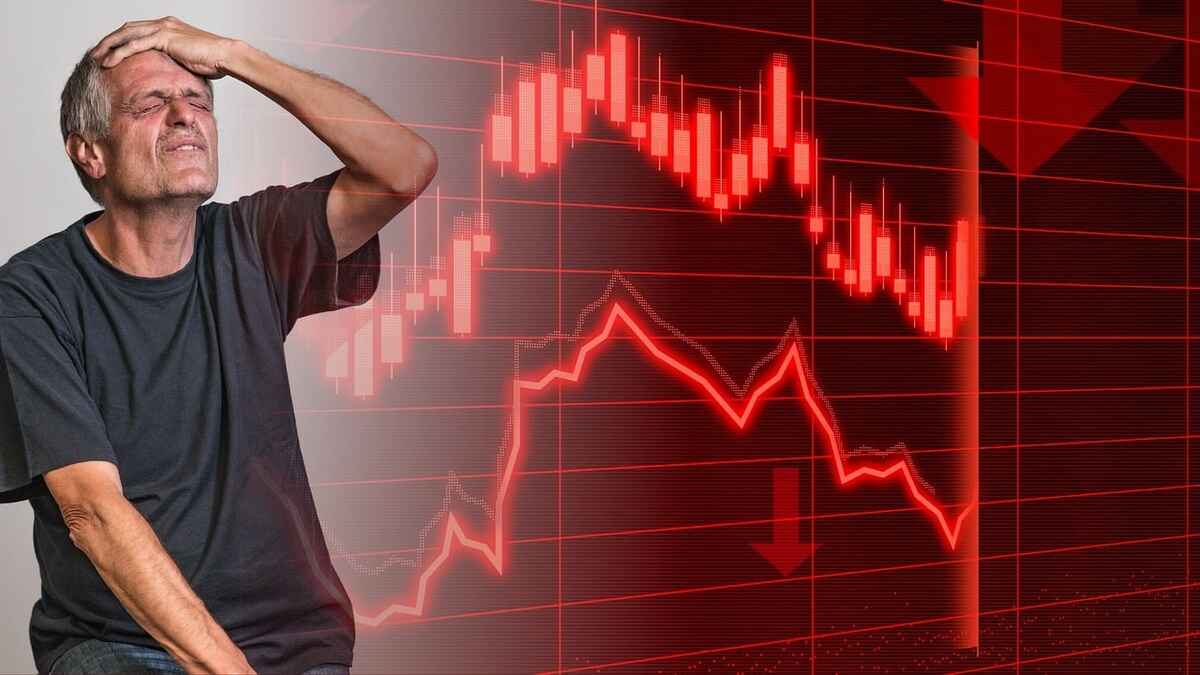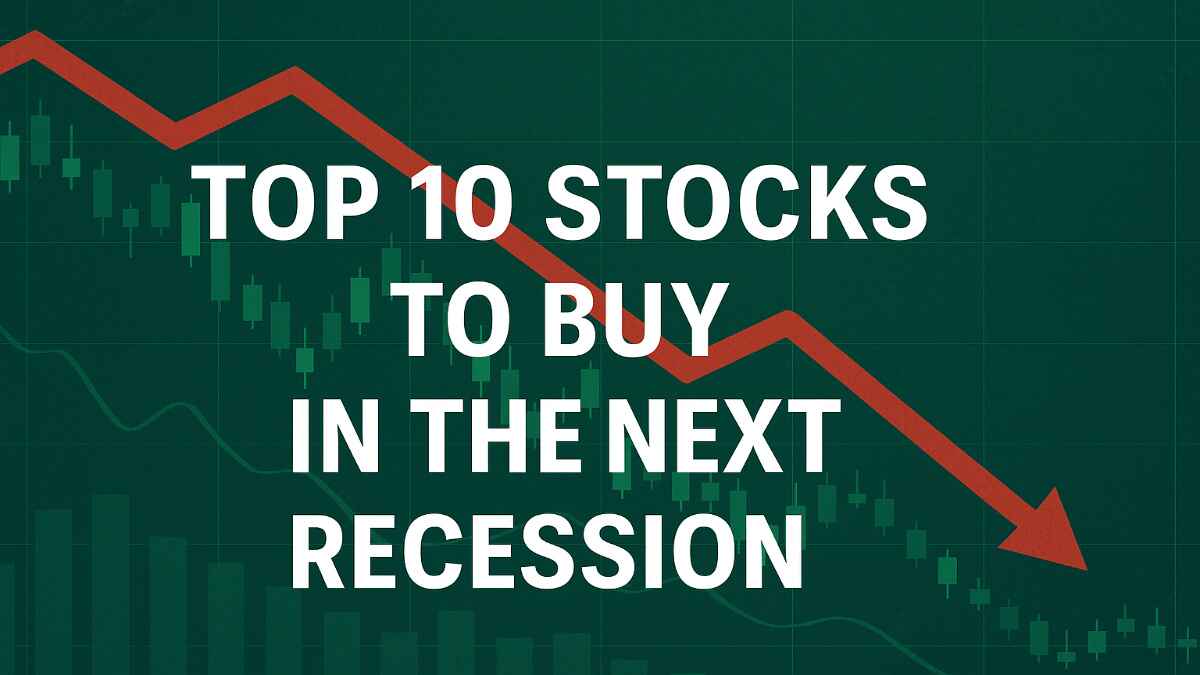Introduction
A recession, typically defined as two consecutive quarters of negative GDP growth, brings economic challenges like reduced consumer spending, business cost-cutting, and stock market volatility. However, certain companies, known as recession-proof or defensive stocks, maintain steady revenues and profits by providing essential goods and services. With a potential recession looming in 2025, driven by factors like trade wars and tariffs, investors are seeking stable investments.
This article explores the top 10 stocks to buy in the next recession, selected for their historical resilience, strong fundamentals, and consistent dividends. These stocks can help protect your portfolio and potentially generate returns during economic downturns.
Table of Contents
Why Invest in Recession-Proof Stocks?
Investing in recession-proof stocks offers several benefits:
- Stability: These stocks are less volatile than the broader market, providing a safer haven during economic turbulence.
- Dividends: Many offer consistent dividends, ensuring income even when stock prices dip.
- Growth Potential: While growth may slow, these companies often maintain earnings and dividends over the long term.
- Defensive Sectors: Sectors like consumer staples, healthcare, utilities, and telecom provide essential products or services, maintaining demand regardless of economic conditions.
Below, we detail the top 10 stocks to buy in the next recession, focusing on their historical performance, competitive advantages, and why they’re suited for a 2025 downturn.
Top 10 Stocks to Buy in the Next Recession

1. Walmart (WMT)
Sector: Consumer Staples/Retail
Why It’s Recession-Proof: Walmart, the world’s largest retailer, operates a vast network of stores selling essential goods like groceries and household items. During recessions, consumers prioritize affordability, boosting Walmart’s value-driven model.
Historical Performance: In the 2007-2009 Great Recession, Walmart’s stock declined by only 16%, compared to the S&P 500’s 55% drop. During the COVID-19 pandemic, its stock thrived as consumers stocked up on essentials.
Dividends: Walmart, a Dividend King, has increased its dividend for 51 consecutive years, with a current yield of about 1.4%.
Competitive Advantages: Walmart’s scale enables cost negotiations with suppliers, keeping prices low. Its omnichannel strategy, blending physical stores with e-commerce, ensures future growth.
Why Buy in 2025?: With tariff-driven inflation risks in 2025, Walmart’s low-cost model positions it to capture budget-conscious shoppers.
2. Procter & Gamble (PG)
Sector: Consumer Staples
Why It’s Recession-Proof: Procter & Gamble manufactures household essentials like Tide, Pampers, and Crest, which enjoy strong brand loyalty. These products remain in demand even during economic downturns.
Historical Performance: PG’s stock fell 36% during the 2007-2009 recession, outperforming the S&P 500’s 55% decline, showcasing its stability.
Dividends: A Dividend King, PG has raised dividends for 68 years, with a current yield of ~2.7%.
Competitive Advantages: PG’s trusted brands provide pricing power, maintaining margins despite rising costs. Its global presence diversifies risk.
Why Buy in 2025?: PG’s essential products and dividend reliability make it a safe bet for recessionary pressures.
3. Johnson & Johnson (JNJ)
Sector: Healthcare
Why It’s Recession-Proof: Johnson & Johnson operates in pharmaceuticals, medical devices, and consumer health, producing essentials like Band-Aid and Tylenol. Healthcare demand remains steady in recessions.
Historical Performance: JNJ’s stock dropped 27% during the 2007-2009 recession, faring better than the S&P 500.
Dividends: JNJ has increased dividends for 62 years, with a current yield of ~3.4%.
Competitive Advantages: Its diversified business model and robust R&D pipeline reduce risk and drive innovation.
Why Buy in 2025?: JNJ’s essential healthcare offerings ensure stability amid economic uncertainty.
4. Coca-Cola (KO)
Sector: Consumer Staples
Why It’s Recession-Proof: Coca-Cola’s iconic beverages, including Sprite and Dasani, are consumed daily worldwide, ensuring consistent demand.
Historical Performance: KO’s stock fell 31% during the 2007-2009 recession, outperforming the S&P 500.
Dividends: A Dividend King, KO has raised dividends for 62 years, with a current yield of ~2.9%.
Competitive Advantages: Strong brand loyalty and a global distribution network provide a competitive edge.
Why Buy in 2025?: Coca-Cola’s global reach and essential products make it resilient to economic shifts.
5. PepsiCo (PEP)
Sector: Consumer Staples
Why It’s Recession-Proof: PepsiCo’s beverage and snack portfolio, including Lay’s and Quaker Oats, diversifies its revenue streams, ensuring stability.
Historical Performance: PEP’s stock declined 36% during the 2007-2009 recession, better than the S&P 500.
Dividends: PEP has increased dividends for 53 years, with a current yield of ~3.0%.
Competitive Advantages: Its dual focus on beverages and snacks captures varied consumer needs, supported by strong marketing.
Why Buy in 2025?: PepsiCo’s diversified portfolio and global presence make it a strong recession pick.
6. NextEra Energy (NEE)
Sector: Utilities
Why It’s Recession-Proof: NextEra Energy, a leader in clean energy, owns Florida Power & Light and a growing renewable energy segment. Utilities provide essential services, ensuring steady demand.
Historical Performance: Utility stocks, including NEE, typically outperform during recessions due to their necessity.
Dividends: NEE has raised dividends for 32 years, with a current yield of ~3.5%.
Competitive Advantages: Its leadership in renewables positions it for growth, while its regulated utility business ensures stable cash flows.
Why Buy in 2025?: NEE’s focus on sustainable energy aligns with long-term trends, making it a safe and growth-oriented choice.
7. Exxon Mobil (XOM)
Sector: Energy
Why It’s Recession-Proof: Despite the cyclical nature of energy, Exxon Mobil’s integrated business model and dividend history make it a reliable choice.
Historical Performance: XOM’s stock fell 28% during the 2007-2009 recession, outperforming the S&P 500.
Dividends: With a 143-year dividend streak, XOM offers a current yield of ~3.8%.
Competitive Advantages: Its scale and cost discipline support profitability even in volatile markets.
Why Buy in 2025?: XOM’s dividend reliability and diversified operations make it a strong income play.
8. AbbVie (ABBV)
Sector: Healthcare
Why It’s Recession-Proof: AbbVie, known for Humira, focuses on high-margin pharmaceuticals, ensuring steady demand for its treatments.
Historical Performance: As a newer company (spun off in 2013), AbbVie inherits Abbott’s recession resilience. Healthcare stocks generally perform well in downturns.
Dividends: ABBV offers a ~4.4% yield, with consistent increases since inception.
Competitive Advantages: A strong patent portfolio and R&D pipeline ensure long-term growth.
Why Buy in 2025?: AbbVie’s essential drugs and high yield make it a solid recession choice.
9. Unilever (UL)
Sector: Consumer Staples
Why It’s Recession-Proof: Unilever’s brands, like Dove and Lipton, are everyday essentials with global demand.
Historical Performance: Unilever has historically maintained stability during downturns due to its essential products.
Dividends: UL has raised dividends for 30 years, with a current yield of ~3.5%.
Competitive Advantages: Its diverse portfolio and emerging market presence reduce risk.
Why Buy in 2025?: Unilever’s global reach and essential products ensure resilience.
10. McDonald’s (MCD)
Sector: Consumer Staples
Why It’s Recession-Proof: McDonald’s affordable meals attract consumers trading down during recessions.
Historical Performance: MCD’s stock fell 22% during the 2007-2009 recession, outperforming the S&P 500.
Dividends: MCD has increased dividends for 22 years, with a current yield of ~2.5%.
Competitive Advantages: Its global brand, franchise model, and digital innovations ensure stability and growth.
Why Buy in 2025?: McDonald’s value menu and convenience make it a recession winner.
Performance Comparison Table
The following table summarizes the historical performance and dividend yields of the top 10 stocks to buy in the next recession based on the 2007-2009 recession and current data:
| Stock Name | Sector | 2007-09 Recession Return | Dividend Yield | Dividend Streak (Years) |
|---|---|---|---|---|
| Walmart (WMT) | Consumer Staples/Retail | -16% | ~1.4% | 51 |
| Procter & Gamble (PG) | Consumer Staples | -36% | ~2.7% | 68 |
| Johnson & Johnson (JNJ) | Healthcare | -27% | ~3.4% | 62 |
| Coca-Cola (KO) | Consumer Staples | -31% | ~2.9% | 62 |
| PepsiCo (PEP) | Consumer Staples | -36% | ~3.0% | 53 |
| NextEra Energy (NEE) | Utilities | N/A (outperformed sector) | ~3.5% | 32 |
| Exxon Mobil (XOM) | Energy | -28% | ~3.8% | 143 |
| AbbVie (ABBV) | Healthcare | N/A (post-2009 spinoff) | ~4.4% | Since 2013 |
| Unilever (UL) | Consumer Staples | N/A (stable historically) | ~3.5% | 30 |
| McDonald’s (MCD) | Consumer Staples | -22% | ~2.5% | 22 |
Note: N/A indicates data not available for the specific stock during the 2007-2009 period or not explicitly listed in sources.
Why These Stocks Are Recession-Proof
These stocks were selected based on:
- Historical Resilience: Most outperformed the S&P 500 during the 2007-2009 recession, with declines significantly lower than the market’s 55% drop.
- Defensive Sectors: Consumer staples, healthcare, and utilities dominate due to consistent demand for essentials.
- Dividend Reliability: Long dividend streaks and attractive yields provide income stability.
- Strong Fundamentals: Low debt, strong cash flows, and competitive advantages like brand loyalty or scale ensure financial health.
Risks to Consider
While these stocks are considered recession-proof, they are not immune to declines. Severe recessions can impact even defensive sectors, and factors like tariff-driven inflation or supply chain disruptions could affect performance. Diversification and personal research are crucial to mitigate risks.
FAQs
What is a recession-proof stock?
A recession-proof stock belongs to a company whose business remains stable during economic downturns, typically in sectors like consumer staples, healthcare, or utilities where demand for essentials persists.
How can I invest during a recession?
Focus on defensive sectors, prioritize companies with strong balance sheets and dividends, and diversify your portfolio. Consulting a financial advisor can help tailor your strategy
Are there risks to buying stocks during a recession?
Yes, even recession-proof stocks can decline in severe downturns. However, they typically recover faster and outperform the broader market.
How long do recessions last?
On average, U.S. recessions last about 10 months, though stock market impacts may persist longer.
Should I sell growth stocks during a recession?
If you’re a long-term investor, holding growth stocks may be wise, as they can rebound post-recession. For short-term needs or risk aversion, reallocating to defensive stocks may be prudent.
Conclusion
Investing in the top 10 stocks to buy in the next recession—Walmart, Procter & Gamble, Johnson & Johnson, Coca-Cola, PepsiCo, NextEra Energy, Exxon Mobil, AbbVie, Unilever, and McDonald’s—offers a strategic way to navigate a 2025 downturn. These companies have proven resilience, strong fundamentals, and reliable dividends, making them ideal for stability-focused investors. While no stock is entirely risk-free, these selections are well-positioned to weather economic challenges. Conduct thorough research and align investments with your financial goals to maximize success.
Disclaimer: Moneyjack.in provides general financial information for educational purposes only. We are not financial advisors. Content is not personalized advice. Consult a qualified professional before making financial decisions. We are not liable for any losses or damages arising from the use of our content. Always conduct your own research.
